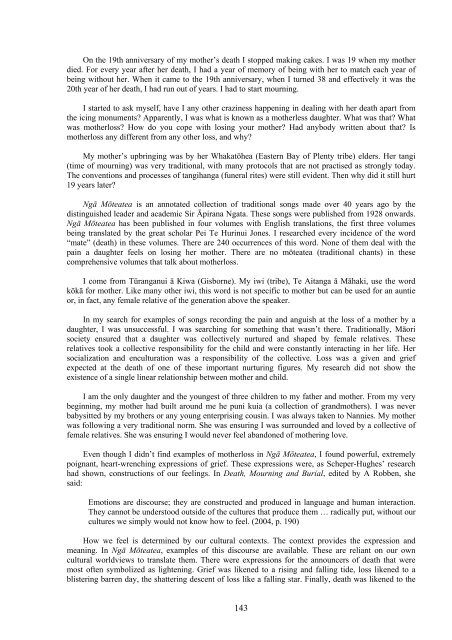traditional knowledge conference 2008 te tatau pounamu
traditional knowledge conference 2008 te tatau pounamu
traditional knowledge conference 2008 te tatau pounamu
You also want an ePaper? Increase the reach of your titles
YUMPU automatically turns print PDFs into web optimized ePapers that Google loves.
On the 19th anniversary of my mother’s death I stopped making cakes. I was 19 when my motherdied. For every year af<strong>te</strong>r her death, I had a year of memory of being with her to match each year ofbeing without her. When it came to the 19th anniversary, when I turned 38 and effectively it was the20th year of her death, I had run out of years. I had to start mourning.I star<strong>te</strong>d to ask myself, have I any other craziness happening in dealing with her death apart fromthe icing monuments? Apparently, I was what is known as a motherless daugh<strong>te</strong>r. What was that? Whatwas motherloss? How do you cope with losing your mother? Had anybody writ<strong>te</strong>n about that? Ismotherloss any different from any other loss, and why?My mother’s upbringing was by her Whakatōhea (Eas<strong>te</strong>rn Bay of Plenty tribe) elders. Her tangi(time of mourning) was very <strong>traditional</strong>, with many protocols that are not practised as strongly today.The conventions and processes of tangihanga (funeral ri<strong>te</strong>s) were still evident. Then why did it still hurt19 years la<strong>te</strong>r?Ngā Mō<strong>te</strong>a<strong>te</strong>a is an annota<strong>te</strong>d collection of <strong>traditional</strong> songs made over 40 years ago by thedistinguished leader and academic Sir Āpirana Ngata. These songs were published from 1928 onwards.Ngā Mō<strong>te</strong>a<strong>te</strong>a has been published in four volumes with English translations, the first three volumesbeing transla<strong>te</strong>d by the great scholar Pei Te Hurinui Jones. I researched every incidence of the word“ma<strong>te</strong>” (death) in these volumes. There are 240 occurrences of this word. None of them deal with thepain a daugh<strong>te</strong>r feels on losing her mother. There are no mō<strong>te</strong>a<strong>te</strong>a (<strong>traditional</strong> chants) in thesecomprehensive volumes that talk about motherloss.I come from Tūranganui ā Kiwa (Gisborne). My iwi (tribe), Te Aitanga ā Māhaki, use the wordkōkā for mother. Like many other iwi, this word is not specific to mother but can be used for an auntieor, in fact, any female relative of the generation above the speaker.In my search for examples of songs recording the pain and anguish at the loss of a mother by adaugh<strong>te</strong>r, I was unsuccessful. I was searching for something that wasn’t there. Traditionally, Māorisociety ensured that a daugh<strong>te</strong>r was collectively nurtured and shaped by female relatives. Theserelatives took a collective responsibility for the child and were constantly in<strong>te</strong>racting in her life. Hersocialization and enculturation was a responsibility of the collective. Loss was a given and griefexpec<strong>te</strong>d at the death of one of these important nurturing figures. My research did not show theexis<strong>te</strong>nce of a single linear relationship between mother and child.I am the only daugh<strong>te</strong>r and the youngest of three children to my father and mother. From my verybeginning, my mother had built around me he puni kuia (a collection of grandmothers). I was neverbabysit<strong>te</strong>d by my brothers or any young en<strong>te</strong>rprising cousin. I was always taken to Nannies. My motherwas following a very <strong>traditional</strong> norm. She was ensuring I was surrounded and loved by a collective offemale relatives. She was ensuring I would never feel abandoned of mothering love.Even though I didn’t find examples of motherloss in Ngā Mō<strong>te</strong>a<strong>te</strong>a, I found powerful, extremelypoignant, heart-wrenching expressions of grief. These expressions were, as Scheper-Hughes’ researchhad shown, constructions of our feelings. In Death, Mourning and Burial, edi<strong>te</strong>d by A Robben, shesaid:Emotions are discourse; they are construc<strong>te</strong>d and produced in language and human in<strong>te</strong>raction.They cannot be understood outside of the cultures that produce them … radically put, without ourcultures we simply would not know how to feel. (2004, p. 190)How we feel is de<strong>te</strong>rmined by our cultural con<strong>te</strong>xts. The con<strong>te</strong>xt provides the expression andmeaning. In Ngā Mō<strong>te</strong>a<strong>te</strong>a, examples of this discourse are available. These are reliant on our owncultural worldviews to transla<strong>te</strong> them. There were expressions for the announcers of death that weremost of<strong>te</strong>n symbolized as ligh<strong>te</strong>ning. Grief was likened to a rising and falling tide, loss likened to ablis<strong>te</strong>ring barren day, the shat<strong>te</strong>ring descent of loss like a falling star. Finally, death was likened to the143
















